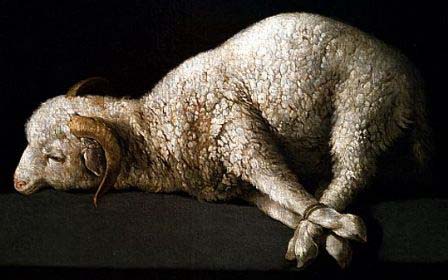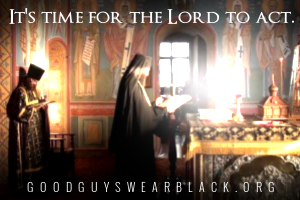
by Fr. Patrick Henry Reardon
Very early in the Fourth Gospel, John the Baptist sees Jesus and exclaims,
“Behold the Lamb of God, who takes away the sins of the world!” (John 1:29)
The Evangelist tells us that John repeated this identification on the following day (1:36).
For the rest of the Fourth Gospel, nothing more is said of John’s exclamation; he identified Jesus as the sacrificial lamb, but the theme is not further pursued in the story.
When Jesus dies, however, the Evangelist suddenly comments on the fact that Jesus’ legs were not broken on the Cross. Interpreting this fact as a fulfillment of biblical prophecy, he quotes the Book of Exodus:
“Not one of his bones shall be broken” (19:36; Exodus 12:46).
John expects his readers to be familiar with that text; he assumes they will recognize that this verse pertains to the Paschal Lamb. In citing it, John identifies Jesus as the true Paschal Lamb.
If we look closely at this imagery, however, we recognize that the image of Jesus as Paschal Lamb has passed through a filter, so to speak. In the Mosaic Law the paschal lamb was not a sin offering. It was a special sacrifice immediately tied to Israel’s deliverance from Egyptian slavery. It represented—if the expression be allowed—the embodiment of liberation from slavery.
How, then, does John the Baptist, who identifies Jesus as the Paschal Lamb, declare that he takes away the sins of the world? Here is where I want to employ the metaphor of the filter: the theme of the paschal lamb has been filtered through the Isaian image of the Suffering Servant, whom the prophet declares,
“He was led as a sheep to the slaughter, and as a lamb is silent before his shearers, so he opens not his mouth.”
The original lamb was not a sin offering; it was offered in the context of Israel’s deliverance from slavery. The blood of that lamb marked the doorposts of the houses of the Israelites, so that the angel of the Lord would spare those houses the dreadful tenth plague which was visited on Egypt on the night of Passover.
This new Lamb of God, however, does more than free the Israelites from servitude in Egypt. He is the Suffering Servant of the Lord, described in the Book of Isaiah as a sin offering. This new Paschal Lamb takes away the sins of the whole world. He does not perish for one people only, but to gather into one all the scattered children of God. This verse from Exodus, cited at the scene on the Cross, ties the end of John’s account back to the exclamation of John the Baptist in the first chapter.
This imagery ties St. John’s theology to that of St. Paul, who wrote to the Corinthians,
“Christ, our paschal lamb, has been sacrificed.”
It ties John also to Peter, who declared our redemption by
“the precious blood of Christ, as of a lamb without blemish and without spot” (1 Peter 1:19).
We are now observing the Christian Passover, that feast of which St. Gregory the Theologian wrote,
“Then comes the Sacred Night, the anniversary of the confused darkness of the present life, into which the primeval darkness is dissolved, and all things come into life and rank and form, and that which was chaos is constrained to order. Then we flee from Egypt; that is, from sullen persecuting sin; and from Pharaoh the unseen tyrant . . . (Orations 45.25).
St. Gregory perceives the conflation of the imagery from Exodus 12 and Isaiah 53. Here is how he describes the Paschal Lamb:
“Thus then and for this cause the written Law came in, gathering us into Christ; and this is the account of the Sacrifices as I account for them. And that you may not be ignorant of the depth of His Wisdom and the riches of His inscrutable judgments. He did not leave even these unhallowed altogether, or useless, or with nothing in them but mere blood. But that great—and if I may say so—in its first [divine] nature ‘unsacrificeable’ Victim was intermingled with the Sacrifices of the Law, and was a purification, not for a part of the world, nor for only a short time, but for the whole world and for all time.”
Recognizing that the wool of the lamb—though it is the lamb’s native nakedness—provides the clothing for the human being, Gregory transposes this imagery to the case of Christ, whose very innocence becomes the proper clothing for the wedding feast, the very garment of incorruption:
“For this reason a Lamb was chosen for its innocence, and its clothing of the original nakedness. For such is the Victim offered for us, who is both in name and fact the garment of incorruption.”
Gregory continues the symbolism of the lamb, finally identifying it with the suffering Victim in Isaiah 53:
“And he was a perfect Victim not only on account of his divinity, than which nothing is more perfect; but also on account of that which he assumed, having been anointed with the divinity, and having become one with Him who anointed it, and I am bold to say, made equal with God. He was a male, because he was offered for Adam . . . He both took on Him our sins and bore our weakness (Isaiah 53:4), yet he did not himself suffer anything that needed healing. For he was tempted in all points like as we are yet without sin. For he that persecuted the Light that shines in darkness could not overcome him” (45.13).
This is the meaning of the Passover, said Gregory, because
“the Lamb is slain, and act and word are sealed with the Precious Blood” (45.25).
He goes on,
“we will feed on the Lamb toward evening— for Christ’s Passion was in the completion of the ages; because, in addition, he communicated his disciples in the evening with his Sacrament, destroying the darkness of sin” (45.26).
Here we perceive the symbolism of the darkness that covered the earth for three hours, as the true Paschal Lamb was being slain. Here we detect the mystery of the redemptive blood that flowed from his side to anoint our hearts and minds against the avenging angel.
